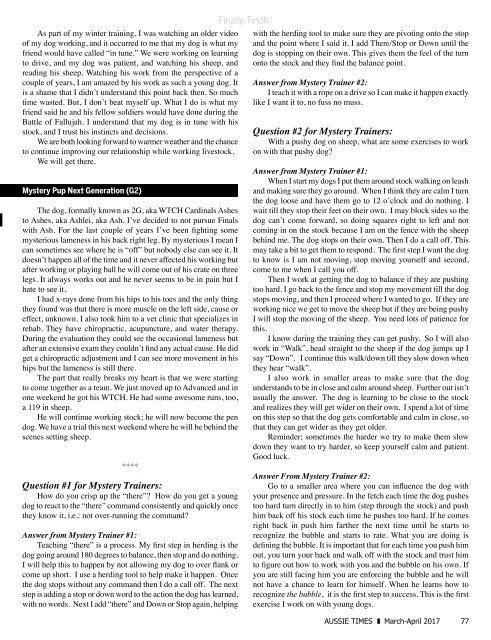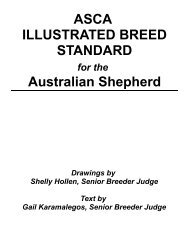You also want an ePaper? Increase the reach of your titles
YUMPU automatically turns print PDFs into web optimized ePapers that Google loves.
As part of my winter training, I was watching an older video<br />
of my dog working, and it occurred to me that my dog is what my<br />
friend would have called “in tune.” We were working on learning<br />
to drive, and my dog was patient, and watching his sheep, and<br />
reading his sheep. Watching his work from the perspective of a<br />
couple of years, I am amazed by his work as such a young dog. It<br />
is a shame that I didn’t understand this point back then. So much<br />
time wasted. But, I don’t beat myself up. What I do is what my<br />
friend said he and his fellow soldiers would have done during the<br />
Battle of Fallujah. I understand that my dog is in tune with his<br />
stock, and I trust his instincts and decisions.<br />
We are both looking forward to warmer weather and the chance<br />
to continue improving our relationship while working livestock.<br />
We will get there.<br />
Mystery Pup Next Generation (G2)<br />
The dog, formally known as 2G, aka WTCH Cardinals Ashes<br />
to Ashes, aka Ashlei, aka Ash. I’ve decided to not pursue Finals<br />
with Ash. For the last couple of years I’ve been fighting some<br />
mysterious lameness in his back right leg. By mysterious I mean I<br />
can sometimes see where he is “off” but nobody else can see it. It<br />
doesn’t happen all of the time and it never affected his working but<br />
after working or playing ball he will come out of his crate on three<br />
legs. It always works out and he never seems to be in pain but I<br />
hate to see it.<br />
I had x-rays done from his hips to his toes and the only thing<br />
they found was that there is more muscle on the left side, cause or<br />
effect, unknown. I also took him to a vet clinic that specializes in<br />
rehab. They have chiropractic, acupuncture, and water therapy.<br />
During the evaluation they could see the occasional lameness but<br />
after an extensive exam they couldn’t find any actual cause. He did<br />
get a chiropractic adjustment and I can see more movement in his<br />
hips but the lameness is still there.<br />
The part that really breaks my heart is that we were starting<br />
to come together as a team. We just moved up to Advanced and in<br />
one weekend he got his WTCH. He had some awesome runs, too,<br />
a 119 in sheep.<br />
He will continue working stock; he will now become the pen<br />
dog. We have a trial this next weekend where he will be behind the<br />
scenes setting sheep.<br />
****<br />
Question #1 for Mystery Trainers:<br />
How do you crisp up the “there”? How do you get a young<br />
dog to react to the “there” command consistently and quickly once<br />
they know it, i.e.: not over-running the command?<br />
Answer from Mystery Trainer #1:<br />
Teaching “there” is a process. My first step in herding is the<br />
dog going around 180 degrees to balance, then stop and do nothing.<br />
I will help this to happen by not allowing my dog to over flank or<br />
come up short. I use a herding tool to help make it happen. Once<br />
the dog stops without any command then I do a call off. The next<br />
step is adding a stop or down word to the action the dog has learned,<br />
with no words. Next I add “there” and Down or Stop again, helping<br />
Finally, Finals!<br />
with the herding tool to make sure they are pivoting onto the stop<br />
and the point where I said it. I add There/Stop or Down until the<br />
dog is stopping on their own. This gives them the feel of the turn<br />
onto the stock and they find the balance point.<br />
Answer from Mystery Trainer #2:<br />
I teach it with a rope on a drive so I can make it happen exactly<br />
like I want it to, no fuss no muss.<br />
Question #2 for Mystery Trainers:<br />
With a pushy dog on sheep, what are some exercises to work<br />
on with that pushy dog?<br />
Answer from Mystery Trainer #1:<br />
When I start my dogs I put them around stock walking on leash<br />
and making sure they go around. When I think they are calm I turn<br />
the dog loose and have them go to 12 o’clock and do nothing. I<br />
wait till they stop their feet on their own. I may block sides so the<br />
dog can’t come forward, so doing squares right to left and not<br />
coming in on the stock because I am on the fence with the sheep<br />
behind me. The dog stops on their own. Then I do a call off. This<br />
may take a bit to get them to respond. The first step I want the dog<br />
to know is I am not moving, stop moving yourself and second,<br />
come to me when I call you off.<br />
Then I work at getting the dog to balance if they are pushing<br />
too hard. I go back to the fence and stop my movement till the dog<br />
stops moving, and then I proceed where I wanted to go. If they are<br />
working nice we get to move the sheep but if they are being pushy<br />
I will stop the moving of the sheep. You need lots of patience for<br />
this.<br />
I know during the training they can get pushy. So I will also<br />
work in “Walk”, head straight to the sheep if the dog jumps up I<br />
say “Down”. I continue this walk/down till they slow down when<br />
they hear “walk”.<br />
I also work in smaller areas to make sure that the dog<br />
understands to be in close and calm around sheep. Further out isn’t<br />
usually the answer. The dog is learning to be close to the stock<br />
and realizes they will get wider on their own. I spend a lot of time<br />
on this step so that the dog gets comfortable and calm in close, so<br />
that they can get wider as they get older.<br />
Reminder; sometimes the harder we try to make them slow<br />
down they want to try harder, so keep yourself calm and patient.<br />
Good luck.<br />
Answer From Mystery Trainer #2:<br />
Go to a smaller area where you can influence the dog with<br />
your presence and pressure. In the fetch each time the dog pushes<br />
too hard turn directly in to him (step through the stock) and push<br />
him back off his stock each time he pushes too hard. If he comes<br />
right back in push him farther the next time until he starts to<br />
recognize the bubble and starts to rate. What you are doing is<br />
defining the bubble. It is important that for each time you push him<br />
out, you turn your back and walk off with the stock and trust him<br />
to figure out how to work with you and the bubble on his own. If<br />
you are still facing him you are enforcing the bubble and he will<br />
not have a chance to learn for himself. When he learns how to<br />
recognize the bubble, it is the first step to success. This is the first<br />
exercise I work on with young dogs.<br />
AUSSIE TIMES <strong>March</strong>-<strong>April</strong> <strong>2017</strong> 77



